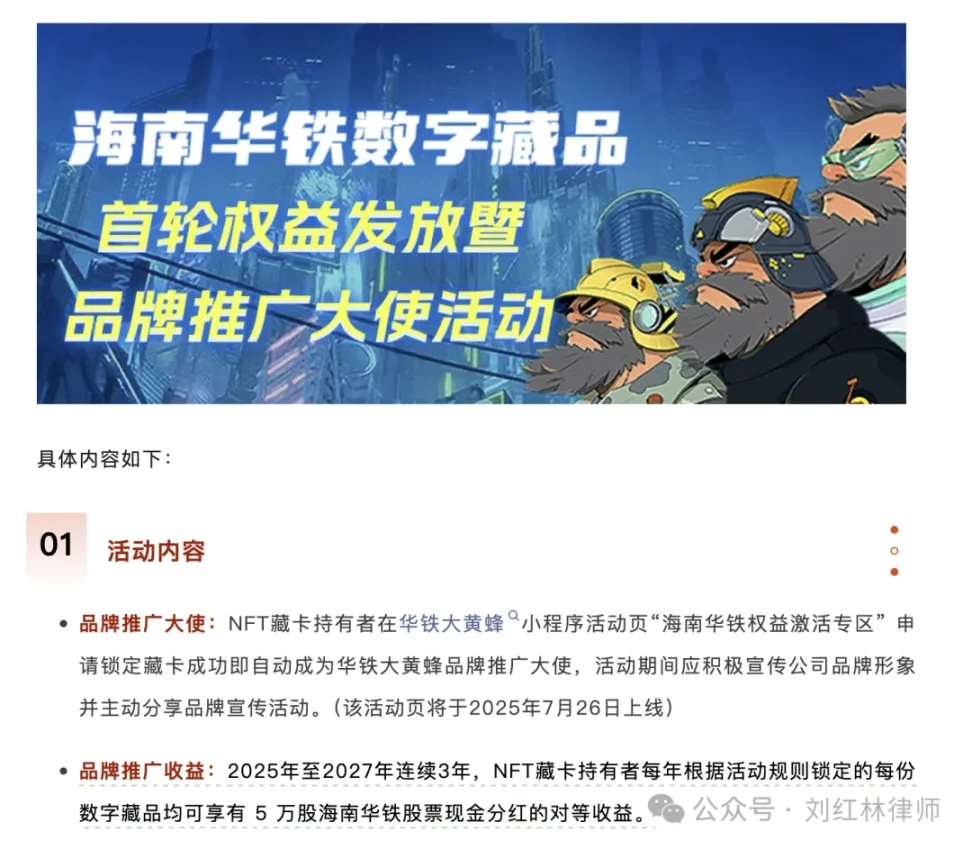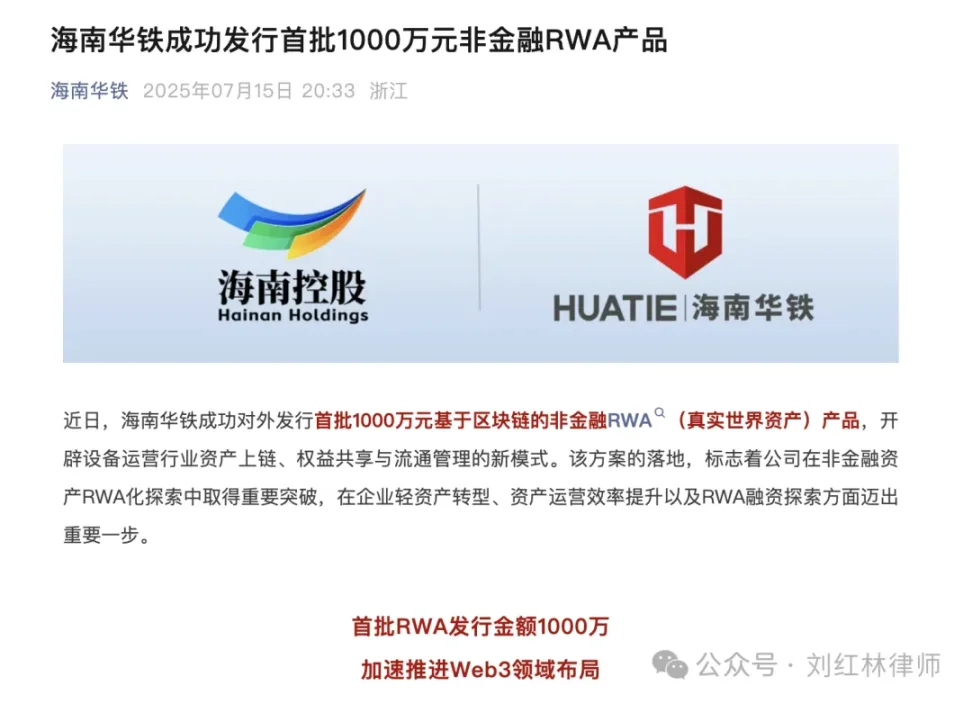Author: Liu Honglin
In the past few days, Hainan Huatie has suddenly become a common topic in the Web3 circle and the A-share community.
On one side, the "Wasp Brother NFT" saw its floor price rise from 200 yuan to nearly 15,000 yuan within three days, dominating discussions in the digital collectibles space; on the other side, the company officially announced the completion of its first batch of 10 million yuan non-financial RWA (Real World Assets) product issuance, in collaboration with the well-known licensed Web3 company Weiyi Digital. To many bewildered onlookers, this seems to be a new signal of "public companies entering Web3," a model of "on-chain assets + profit sharing."
Outsiders watch the excitement, while insiders see the nuances. Hainan Huatie's seemingly innovative approach, from NFTs to RWAs, is actually "navigating" the legal and regulatory gray areas.
Lawyer Honglin's personal view is that Hainan Huatie is not a commendable compliance pilot, but rather may become a typical case of future risk explosion.
From NFT to RWA: What is Hainan Huatie really playing at?
First, let's talk about NFTs, specifically the "Wasp Brother."
This NFT is not just a simple digital collectible; it is tied to the rights to "brand promotion earnings" for three consecutive years. According to the official rules released by the company in July, as long as users activate and lock the NFT through the "Huatie Wasp" WeChat mini-program between July 26 and August 1, they automatically become "brand promotion ambassadors" and can receive cash earnings equivalent to "the dividend amount of 50,000 shares of Hainan Huatie stock" for three consecutive years from 2025 to 2027.

The key points of this model are:
- The earnings amount is linked to the company's stock dividends;
- Locking the card is a prerequisite for qualification, and it must be reactivated each year;
- The company reserves the unilateral right to interpret and cancel qualifications;
- If a user makes statements online that "damage the brand image," their qualification can be revoked.
In short, you are not purchasing a collectible; you are signing an unequal agreement of "behavior code in exchange for profit rights."
Next, let's look at the RWA project. This is Hainan Huatie's attempt to take a further step in the industry narrative of "asset on-chain."

The company claims to have partnered with the licensed Web3 company Weiyi Digital to complete the issuance of the first batch of non-financial RWA products amounting to 10 million yuan.
Unlike common RWAs related to real estate or accounts receivable, this product does not involve the transfer of ownership of equipment but instead "digitally maps" the "usage rights + operational rights" of its equipment, forming a structure similar to a "digital membership card," allowing users to circulate it through on-chain transfer, consignment, etc., while enjoying certain usage rights or benefits.
The key points of this RWA approach are:
- Usage rights are digitized, rather than asset splitting or securitization;
- There is no transfer of ownership, thus avoiding the securities regulatory framework;
- Assets are registered on-chain, but the realization of rights still relies on offline processes;
- A mixed model of "equipment leasing + Web3 rights card" is used for market attempts.
To put it bluntly, these "digital cards" are more like "virtual leasing rights certificates" for engineering equipment, merely packaged as a new concept of "RWA," completing rights registration on-chain and introducing transferability. Combined with the brand communication mechanism of NFTs, Hainan Huatie has constructed a complex structure of "heavy asset operating company + on-chain digital rights + user promotion dividends."
At first glance, this structure seems very Web3-like, achieving asset digitization, user incentives, and driving short-term topic dissemination. But the problem is that all these "innovations" tread on the edge of regulatory red lines, even intentionally blurring legal boundaries.
This is not innovation, but serious edge-rubbing
I do not deny that Hainan Huatie has innovative ideas in digital asset operations, but precisely because it is not a Web3 native company, it is more likely to fall into the trap of "using old thinking in a new shell."
In my view, this model has at least three major issues.
(1) Unclear rights structure, earnings payout relies on company discretion, users cannot protect their rights
Whether it is the "dividend-equivalent earnings" obtained from the NFT lock card or the "equipment usage rights" corresponding to the RWA, the final realization is not based on a real legal contract or smart contract execution, but completely relies on a company rule, a mini-program, and a payment account registration. This model is essentially the company "talking to itself": when it wants to distribute, you can get it; when it doesn't want to, you can't, and you have no right to pursue it.
Such a rights structure does not constitute an enforceable civil contract, nor does it apply to securities or consumer protection mechanisms. Once there is a breach of earnings, qualification cancellation, or rule changes, users have no place to appeal.
(2) "Speech censorship + earnings incentives" combined is an infringement on community governance
Hainan Huatie's rules clearly state: anyone spreading unfavorable remarks on social networks may have their rights revoked by the company. This design of incorporating "speech control" into NFT earnings rules, on the surface, is "brand protection," but in essence, it is a systematic suppression of users' freedom of expression.
Web3 is about freedom and autonomy, not "only those who give a thumbs up can earn money." If this practice is imitated by other companies, the future of digital collectibles will no longer be a space for users' cultural and community spontaneous expression, but a "brand mouthpiece" bound by earnings. This is not ecological construction, but a corporate public relations tool disguised as NFT.
(3) RWA structure blurs the boundaries of financial products, potentially hiding "illegal disguised fundraising" risks
Hainan Huatie did not split asset ownership this time but packaged usage rights into NFTs or digital cards, combined with dividend earnings. The reason this practice has not yet been classified by regulators is that it avoids one or two of the three major characteristics of "public fundraising + promised returns + no financial license." However, the structure itself is still very close to "quasi-financial products."
Once the project continues to expand, increasing the scale of RWAs, designing various rights combinations, or introducing third-party platform trading, expected earnings lock-up, etc., it could easily be classified as "disguised issuance of financial products," or even touch the boundaries of illegal public deposit absorption. Especially in the current context of tightening financial regulation, such "cross-border innovation" could easily lead to accountability if it triggers public opinion or user rights protection.
Lawyer Mankun's Reminder
The biggest problem with this wave of Hainan Huatie's operations is not how bold the marketing is, but how fragile the legal structure and compliance design it relies on.
For ordinary users:
- The NFT you bought is not a property right, nor a share certificate; it is merely a qualification for an activity that "the company says you can earn money if you can earn money";
- Once the rules change, the company incurs losses, or there is a public opinion storm, your "equivalent dividend" may be worth nothing;
- All rights have no statutory guarantee, nor judicial enforceability; the risk relies entirely on "trusting the company."
For Web3 entrepreneurs:
- Do not take Hainan Huatie's approach as an industry model; it solved the issues of dissemination and popularity but did not address legal ownership and user trust mechanisms;
- If you want to do RWA, you can start from non-financial asset structures, but you cannot skip compliance, contracts, and governance;
- NFTs can carry brands and interactions, but cannot replace contracts, shares, and rights; otherwise, it will eventually lead to trouble.
Conclusion: Don't mistake boundary testing for breakthroughs
Hainan Huatie has indeed become popular and is indeed "new." But new ≠ right, popular ≠ stable.
As a compliance lawyer in the Web3 industry, I hope we can see more innovative attempts from listed companies, but this hope is predicated on legality, transparency, and sustainability, rather than wrapping old systems, old logic, and unequal user relationships in "Web3 packaging."
Do not mistake probing the regulatory red line for institutional breakthroughs. That is not progress, but playing with fire.
免责声明:本文章仅代表作者个人观点,不代表本平台的立场和观点。本文章仅供信息分享,不构成对任何人的任何投资建议。用户与作者之间的任何争议,与本平台无关。如网页中刊载的文章或图片涉及侵权,请提供相关的权利证明和身份证明发送邮件到support@aicoin.com,本平台相关工作人员将会进行核查。




